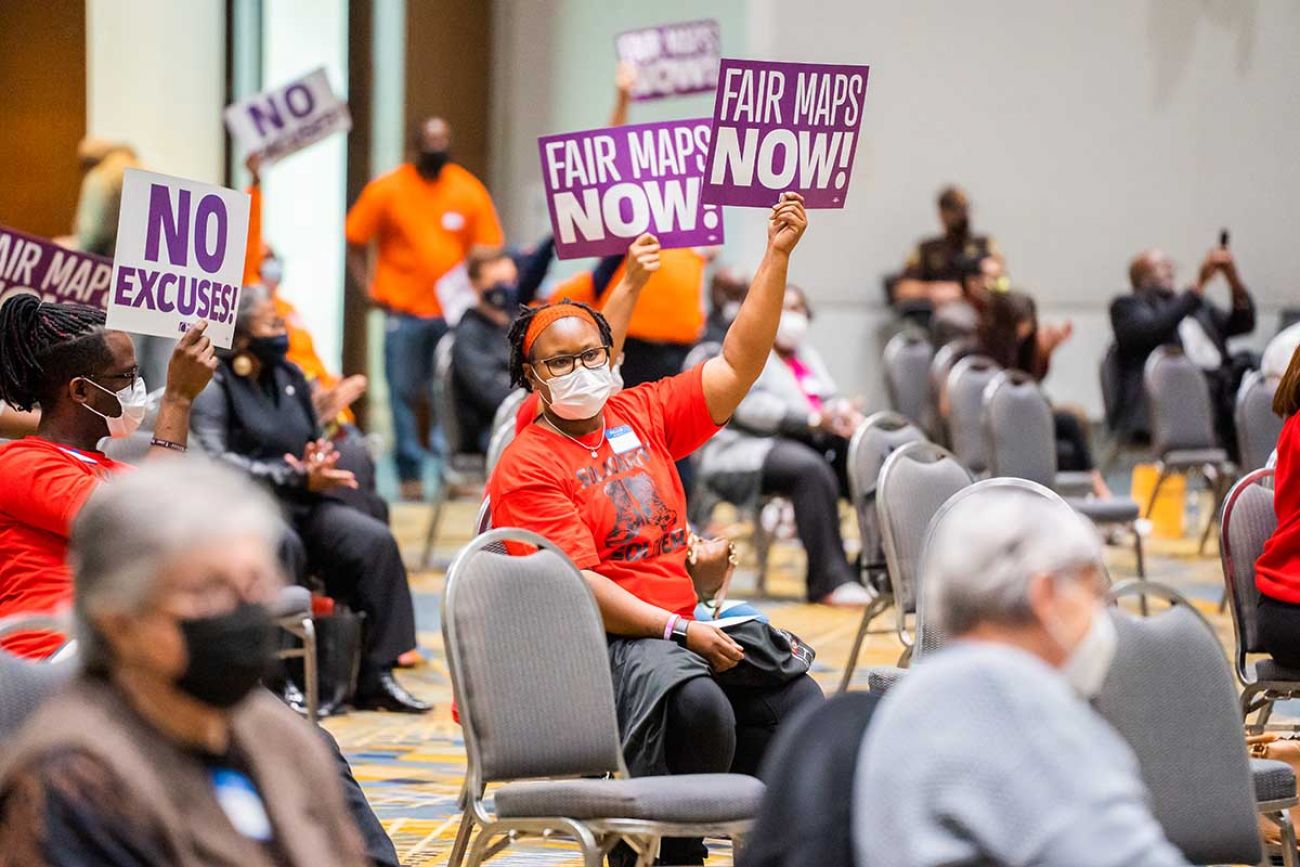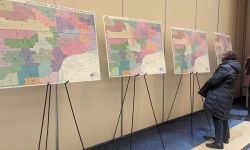Michigan redistricting may help Democrats. But will it hurt Black voters?

Nov. 4: Michigan redistricting commission relents, creates majority-Black maps for House
Nov. 1: Commission approves Senate maps that favor Michigan Democrats
LANSING — Michigan’s citizen redistricting panel could approve maps this month that would make the state far more competitive, giving Democrats a solid chance at controlling the state Legislature for the first time in decades.
But many African-American leaders fear the approach will reduce their clout, as the Michigan Independent Citizens Redistricting Commission’s proposals have far fewer districts where Blacks are an outright majority.
“I don't think they've done a very good job in considering what the unintended consequences are … Why did we become a sacrificial lamb to provide leverage for Democrats?” asked Sherry Gay-Dagnogo, a Democrat who represented Detroit from 2015 to 2020 in the Michigan House.
The controversy begs the question: What percentage of minorities need to be in a district to provide fair representation?
The redistricting commission contends minorities can elect candidates of their choosing with districts that aren’t overwhelmingly composed of people of color.
To do so, the commission has drawn districts in Detroit that stretch into the suburbs, significantly lowering the number of Black voters in districts that are solidly Democratic.
Gay-Dagnogo’s former district, No. 8 in the state House, is now confined to northwest Detroit and is 96.8 percent Black. In 2018, she defeated her challenger by 93 percentage points.
The proposed new district would stay solidly Democratic, but would be 46 percent Black and 50 percent white, and it would stretch for miles into the suburbs to Dearborn Heights.
Many Detroit districts have similar breakdowns, as Sen. Stephanie Chang represents a district that is 80 percent Black. Under redistricting, it would be 41 percent Black and 53 percent white.
Overall, 17 districts in the Legislature are now majority Black.
Under the redistricting plan, only one House district would have a Black voting age population over 50 percent and no Senate districts would.
But 16 House districts and five Senate districts would be 40 percent Black or more under redistricting.
Likewise, two congressional districts that are now overwhelmingly Black — the 13th represented by U.S. Rep. Rashida Tlaib, D-Detroit, and the 14th represented by U.S. Rep. Brenda Lawrence, D-Southfield — would be 44 percent or less African American.
Nick Stephanopolous, a law professor at Harvard University who studies redistricting, told Bridge Michigan that Black voters could have more clout with the new districts.
A Bridge analysis shows the districts favor Democrats in the state Senate, which has been controlled by Republicans since the 1980s, and the House would become significantly more competitive.
Related:
- Michigan redistricting drafts could make state Senate a toss-up
- Republicans have edge, but Michigan House drafts include plenty of surprises
“Is their goal to have a small number of totally safe seats where Black candidates win but then are in the minority in the legislature?” Stephanopolous said. “Think of how much more the Michigan government could do for Black citizens’ priorities if the Black citizens’ preferred party, the Democrats, were in charge of the Michigan legislature.”
Proposed Senate districts
The Michigan Independent Citizens Redistricting Commission is considering the following Senate boundaries. All are named for trees
Senate map ‘Elm’
Source: Bridge Michigan analysis of 2020 election data based on maps provided by the Michigan Independent Citizens Redistricting Commission.
Senate map ‘Cherry’
Source: Bridge Michigan analysis of 2020 election data based on maps provided by the Michigan Independent Citizens Redistricting Commission.
Senate map ‘Spruce’
Source: Bridge Michigan analysis of 2020 election data based on maps provided by the Michigan Independent Citizens Redistricting Commission.
- Graphics by Mike Wilkinson
‘Dem garbage’ and ‘packed districts’
African-American leaders fear the new districts would violate the Voting Rights Act of 1965, which was approved by Congress to protect minority groups.
John E. Johnson, director of the Michigan Department of Civil Rights, contended that Black voters would have less representation in Lansing if their districts stretched into the suburbs.
“The maps this body approved … dilute minority-majority districts and strip the ability for a minority voter to elect legislative representatives who reflect their community and affect any meaningful opportunity to impact public policy and lawmaking,” Johnsons said this month.
The redistricting commission was created in 2018 by voters, replacing a system that allowed the party in power in Lansing to draw the maps every 10 years after the census.
That resulted in gerrymandering that allowed Republicans to maintain control of the state Legislature even in years they got fewer votes overall than Democrats — and the “packing” of minorities into districts that were so lopsidedly Democratic their votes were “wasted.”
A lawsuit over Michigan’s 2010 redistricting process, for instance, uncovered emails from a GOP staffer bragging about drawing districts to “cram ALL the Dem garbage” into four southeast Michigan districts.
Jeff Timmer, a GOP strategist who drew maps in 2010, told Bridge this month that Black Democratic incumbents agreed to “packed” districts because they were safer and guaranteed easy victories.
Bruce Adelson, the commission’s voting rights attorney, said there is no “magic number” of Black voters to include in districts, as long as they are drawn in a way that allows African-American candidates to win.
In some cases, he suggested reducing the percentage of Black voters to 35 percent in Detroit districts.
“If you're using race as the predominant factor in redistricting, that could be considered a racial gerrymander and violate the 14th Amendment of the U.S. Constitution,” Adelson told reporters.
Proposed House districts
The Michigan Independent Citizens Redistricting Commission is considering the following state House boundaries. All are named for trees.
House map ‘Peach’
Source: Bridge Michigan analysis of 2020 election data based on maps provided by the Michigan Independent Citizens Redistricting Commission.
House map ‘Oak’
Source: Bridge Michigan analysis of 2020 election data based on maps provided by the Michigan Independent Citizens Redistricting Commission.
House map ‘Pine’
Source: Bridge Michigan analysis of 2020 election data based on maps provided by the Michigan Independent Citizens Redistricting Commission.
- Graphics by Mike Wilkinson
The U.S. Supreme Court agreed with that interpretation, ruling in 2017 that a numerical majority is not required or needed under the Voting Rights Act. States only need to ensure that minority voters have the ability to elect their candidate of preference, the court ruled.
Mixed results in other states
In other states, overwhelmingly minority districts have been broken up and actually increased representation of people of color.
In 2001, the state of Georgia “unpacked” majority-Black districts, prompting a legal challenge that ended when the U.S. Supreme Court ruled that spreading out Black voters doesn’t violate the Voting Rights Act.
Georgia had 10 Senate districts with a Black voting age population over 50 percent. Redistricting in the early 2000s increased the number to 13 and added five districts with Black populations from 30 percent to 50 percent.
On the other hand, in California, the unpacking of a district harmed the Latino community.
In the 1990s, a congressional district in the San Fernando Valley of Los Angeles became majority Latino. That district was represented by a white Democrat.
In 2001, the California legislature split the district into half, and allocated Latinos in both districts, making them the minority in the districts. They weren’t able to elect their candidate of choice.
In 2011, the California Citizens Redistricting Commission redrew the districts and created a new majority-Latino district. This led to the election of the district’s first Latino member of Congress.
Stephanopolous, the Harvard professor, said Michigan is different, and that the redistricting panel is likely taking into consideration voting patterns of Black and white voters as well, when drawing the new districts.
“It's pretty obvious in a state like Michigan, where a substantial number of white voters vote for minority candidates, that 50 percent is not going to be the correct number,” Stephanopolous said. “It's going to be well south of 50 percent.”
Old thinking?
Republicans have long contended that Michigan’s political geography makes it impossible to draw maps that are both fair to both parties and provide strong minority representation.
Although Michigan is a toss-up state that leans slightly Democratic, Blacks and minorities who vote Democratic are clustered in major cities, while the vast majority of the rest of the state is solidly Republican.
That’s old thinking, several Black and brown Democratic leaders told Bridge, saying it’s possible to have more minority-majority districts and still make the maps more competitive.
Two liberal groups, the Michigan AFL-CIO and Promote The Vote, put out their own maps that would significantly increase the number of Black-majority districts.
The Michigan AFL-CIO’s maps have 12 majority-Black districts in the state House, and five in the Senate along with one district that is one-third people of color.
The AFL-CIO said the maps are competitive between the parties, but the Senate and House maps “have a very slight bias in favor of the Republican Party.”
“Obviously, our map is not perfect. Neither are the maps from the commission,” Martinez said. “But we tried to submit these as an alternate option than what the commission was putting forward.”
The commission is meeting this week and next week to deliberate and decide whether to make changes to the maps.
It is scheduled to vote on Nov. 5 on the final version of proposed maps. It will then take one last vote on Dec. 30.
Although it's a short timeline, some members of the panel have said they are likely to push for changes.
Brittni Kellom, a Democrat on the commission, told reporters last week after a contentious hearing in Detroit “We won't make everyone happy, but there's no way we could possibly ignore” complaints about Black representation.
See what new members are saying about why they donated to Bridge Michigan:
- “In order for this information to be accurate and unbiased it must be underwritten by its readers, not by special interests.” - Larry S.
- “Not many other media sources report on the topics Bridge does.” - Susan B.
- “Your journalism is outstanding and rare these days.” - Mark S.
If you want to ensure the future of nonpartisan, nonprofit Michigan journalism, please become a member today. You, too, will be asked why you donated and maybe we'll feature your quote next time!




